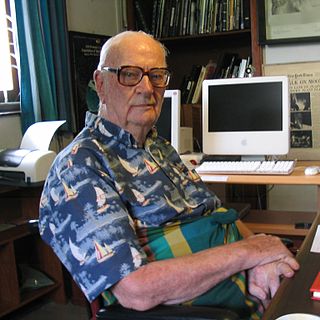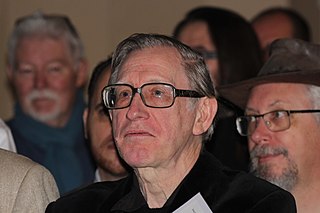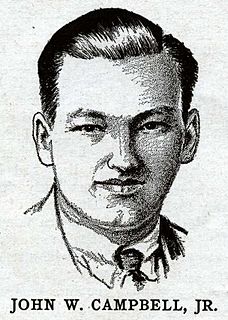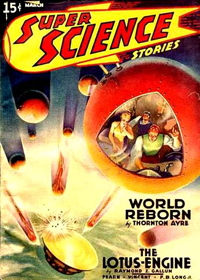Related Research Articles

Hard science fiction is a category of science fiction characterized by concern for scientific accuracy and logic. The term was first used in print in 1957 by P. Schuyler Miller in a review of John W. Campbell's Islands of Space in the November issue of Astounding Science Fiction. The complementary term soft science fiction, formed by analogy to hard science fiction, first appeared in the late 1970s. The term is formed by analogy to the popular distinction between the "hard" (natural) and "soft" (social) sciences. Science fiction critic Gary Westfahl argues that neither term is part of a rigorous taxonomy; instead they are approximate ways of characterizing stories that reviewers and commentators have found useful.

The Encyclopedia of Science Fiction (SFE) is an English language reference work on science fiction, first published in 1979. In October 2011, the third edition was made available for free online.

Dallas McCord "Mack" Reynolds was an American science fiction writer. His pen names included Dallas Ross, Mark Mallory, Clark Collins, Dallas Rose, Guy McCord, Maxine Reynolds, Bob Belmont, and Todd Harding. His work focused on socioeconomic speculation, usually expressed in thought-provoking explorations of utopian societies from a radical, sometime satiric perspective. He was a popular author from the 1950s to the 1970s, especially with readers of science fiction and fantasy magazines.

Abdelkader ibn Muhieddine, known as the Emir Abdelkader or Abdelkader El Djezairi, was an Algerian religious and military leader who led a struggle against the French colonial invasion in the mid-19th century. An Islamic scholar and Sufi who unexpectedly found himself leading a military campaign, he built up a collection of Algerian tribesmen that for many years successfully held out against one of the most advanced armies in Europe. His consistent regard for what would now be called human rights, especially as regards his Christian opponents, drew widespread admiration, and a crucial intervention to save the Christian community of Damascus from a massacre in 1860 brought honours and awards from around the world. Within Algeria, his efforts to unite the country against French invaders saw him hailed as the "modern Jugurtha" and his ability to combine religious and political authority has led to his being acclaimed as the "Saint among the Princes, the Prince among the Saints".
In American science fiction of the 1950s and '60s, psionics was a proposed discipline that applied principles of engineering to the study of paranormal or psychic phenomena, such as telepathy and psychokinesis. The term is a portmanteau of psi and the -onics from electronics. The word "psionics" began as, and always remained, a term of art within the science fiction community and — despite the promotional efforts of editor John W. Campbell, Jr — it never achieved general currency, even among academic parapsychologists. In the years after the term was coined in 1951, it became increasingly evident that no scientific evidence supports the existence of "psionic" abilities.

Brian Michael Stableford is a British science fiction writer who has published more than 70 novels. His earlier books were published under the name Brian M. Stableford, but more recent ones have dropped the middle initial and appeared under the name Brian Stableford. He has also used the pseudonym Brian Craig for a couple of very early works, and again for a few more recent works. The pseudonym derives from the first names of himself and of a school friend from the 1960s, Craig A. Mackintosh, with whom he jointly published some very early work.
In science fiction, uplift is a developmental process to transform a certain species of animals into more intelligent beings by other, already-intelligent beings. This is usually accomplished by cultural, technological, or evolutional interventions like genetic engineering but any fictional or real process can be used. The earliest appearance of the concept is in H. G. Wells' 1896 novel The Island of Doctor Moreau, and more recently appears in David Brin's Uplift series and other science fiction works.

Wonder Stories was an early American science fiction magazine which was published under several titles from 1929 to 1955. It was founded by Hugo Gernsback in 1929 after he had lost control of his first science fiction magazine, Amazing Stories, when his media company Experimenter Publishing went bankrupt. Within a few months of the bankruptcy, Gernsback launched three new magazines: Air Wonder Stories, Science Wonder Stories, and Science Wonder Quarterly.

NESFA Press is the publishing arm of the New England Science Fiction Association, Inc. The NESFA Press primarily produces three types of books:

This is a bibliography of works by American writer John W. Campbell Jr.

Super Science Stories was an American pulp science fiction magazine published by Popular Publications from 1940 to 1943, and again from 1949 to 1951. Popular launched it under their Fictioneers imprint, which they used for magazines, paying writers less than one cent per word. Frederik Pohl was hired in late 1939, at 19 years old, to edit the magazine; he also edited Astonishing Stories, a companion science fiction publication. Pohl left in mid-1941 and Super Science Stories was given to Alden H. Norton to edit; a few months later Norton rehired Pohl as an assistant. Popular gave Pohl a very low budget, so most manuscripts submitted to Super Science Stories had already been rejected by the higher-paying magazines. This made it difficult to acquire good fiction, but Pohl was able to acquire stories for the early issues from the Futurians, a group of young science fiction fans and aspiring writers.

Astounding: John W. Campbell Memorial Anthology is a 1973 anthology honoring American science fiction and fantasy editor John W. Campbell, in the form of an anthology of short stories by various science fiction authors, edited by Harry Harrison. It was first published in hardcover by Random House as a selection of the Science Fiction Book Club, and first published in paperback by Ballantine Books.
A gentleman ranker is an enlisted soldier who may have been a former officer or a gentleman qualified through education and background to be a commissioned officer. It suggests that the signer was born to wealth and privilege but he disgraced himself and has enlisted as a common soldier serving far from the society that now scorns him. Compare to remittance man, often the black sheep of a "good" family, paid a regular allowance to stay abroad, far from home, where he cannot embarrass the family.
William Levi Crawford was an American publisher and editor.
The West African Dwarf or Djallonké is an African breed or group of breeds of domestic sheep. It is the dominant breed of West and Central Africa. This breed is primarily raised for meat.

Black Man's Burden is a science fiction novel by American writer Mack Reynolds. It is the first in a sequence of near-future stories set in North Africa, which also includes Border, Breed nor Birth (1962), "Black Sheep Astray" (1973), and The Best Ye Breed (1978). Black Man's Burden and its sequels have been called a "notable exception" to the indirect treatment of racial issues in 1960s science fiction magazines.

Border, Breed nor Birth is a science fiction novella by American writer Mack Reynolds. It is the second in a sequence of near-future stories set in North Africa, which also includes Black Man's Burden (1961-1962), "Black Sheep Astray" (1973), and The Best Ye Breed (1978). Border, Breed nor Birth and the North Africa series have been called a "notable exception" to the indirect treatment of racial issues in 1960s science fiction magazines.
The Best Ye Breed is a science fiction novella by American writer Mack Reynolds. It is the third in a sequence of near-future stories set in North Africa, which also includes Black Man's Burden (1961-1962), Border, Breed nor Birth (1962), and "Black Sheep Astray" (1973). The Best Ye Breed and the North Africa series have been called a "notable exception" to the indirect treatment of racial issues in 1960s science fiction magazines.

Science-fiction and fantasy magazines began to be published in the United States in the 1920s. Stories with science-fiction themes had been appearing for decades in pulp magazines such as Argosy, but there were no magazines that specialized in a single genre until 1915, when Street & Smith, one of the major pulp publishers, brought out Detective Story Magazine. The first magazine to focus solely on fantasy and horror was Weird Tales, which was launched in 1923, and established itself as the leading weird fiction magazine over the next two decades; writers such as H.P. Lovecraft, Clark Ashton Smith and Robert E. Howard became regular contributors. In 1926 Weird Tales was joined by Amazing Stories, published by Hugo Gernsback; Amazing printed only science fiction, and no fantasy. Gernsback included a letter column in Amazing Stories, and this led to the creation of organized science-fiction fandom, as fans contacted each other using the addresses published with the letters. Gernsback wanted the fiction he printed to be scientifically accurate, and educational, as well as entertaining, but found it difficult to obtain stories that met his goals; he printed "The Moon Pool" by Abraham Merritt in 1927, despite it being completely unscientific. Gernsback lost control of Amazing Stories in 1929, but quickly started several new magazines. Wonder Stories, one of Gernsback's titles, was edited by David Lasser, who worked to improve the quality of the fiction he received. Another early competitor was Astounding Stories of Super-Science, which appeared in 1930, edited by Harry Bates, but Bates printed only the most basic adventure stories with minimal scientific content, and little of the material from his era is now remembered.

Fantasy Book is a defunct semi-professional American science fiction magazine that published eight issues between 1947 and 1951. The editor was William Crawford, and the publisher was Crawford's Fantasy Publishing Company, Inc. Crawford had problems distributing the magazine, and his budget limited the quality of the paper he could afford and the artwork he was able to buy, but he attracted submissions from some well-known writers, including Isaac Asimov, Frederik Pohl, A. E. van Vogt, Robert Bloch, and L. Ron Hubbard. The best-known story to appear in the magazine was Cordwainer Smith's first sale, "Scanners Live in Vain", which was later included in the first Science Fiction Hall of Fame anthology, and is now regarded as one of Smith's finest works. Jack Gaughan, later an award-winning science fiction artist, made his first professional sale to Fantasy Book, for the cover illustrating Smith's story.
References
- ↑ Langford, David, Peter Nicholls, and Brian Stableford. "Race in SF." Encyclopedia of Science Fiction , 3d edition (online). Ed. John Clute, David Langford, and Peter Nicholls. 2012. par. 3. Web.
- ↑ Price, George W. "Mack Reynolds and Politics." eI43 8.2. (April 2009). Web. Text available at eFanzines.com.
- ↑ Reynolds, Mack. "Black Sheep Astray." Astounding: John W. Campbell Memorial Anthology. Ed. Harry Harrison. Random House, 1973. 202. ISBN 978-0-394-48167-8 (10). Print.
- ↑ Safire, William. Watching My Language: Adventures in the Word Trade. New York: Random House, 1997. n.p. ISBN 0679423877 (10). ISBN 978-0679423874 (13). Print.
- ↑ Reynolds, Mack. "Afterword." Foundation 16 (May 1979): 54-55. Print.
- ↑ Smith, Curtis C. Welcome to the Revolution: the Literary Legacy of Mack Reynolds. San Bernardino, CA: Borgo, 1995. 63. ISBN 1557422362 (10). ISBN 978-1557422361 (13).
- ↑ Smith, Curtis C. Welcome to the Revolution: the Literary Legacy of Mack Reynolds. San Bernardino, CA: Borgo, 1995. 71. ISBN 1557422362 (10). ISBN 978-1557422361 (13).